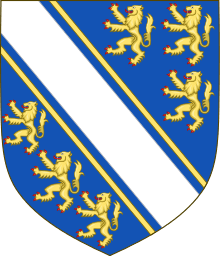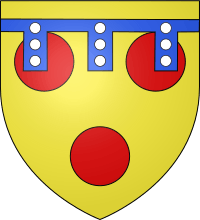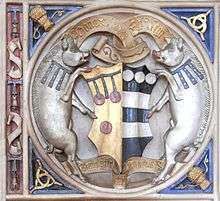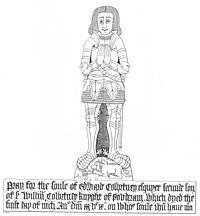Manor of Powderham
Powderham is a former manor on the coast of south Devon, England, situated within the historic hundred of Exminster, about 6 miles (9.7 km) south of the city of Exeter and adjacent to the north-east of the village of Kenton. It consists in part of flat, formerly marshy ground on the west bank of the River Exe estuary where it is joined by its tributary the River Kenn, the site of Powderham Castle, originally the fortified manor house of Powderham. On the opposite side of the Exe is the small village of Lympstone and almost opposite is Nutwell Court in the parish of Woodbury, formerly the castle or fortified manor house of the powerful mediaeval Dynham family.
Descent of the manor
William II, Count of Eu
In the Domesday Book of 1086, the tenant-in-chief of POLDREHA~[1] (Poldreham) is recorded as William II, Count of Eu (d.1096), listed under the heading: Terra Willelmi de Ow ("Lands of William of Eu").[2] Although William II, Count of Eu, held many estates elsewhere in England from the king (in Dorset, Wiltshire, Hampshire, etc.[3]), in Devon he was one of the lesser Devon Domesday Book tenants-in-chief with only two Devonshire holdings, Powderham and nearby Whitestone, both sub-infeudated to his tenant Ranulf. William II, Count of Eu, rebelled against King William II (1087-1100) and was executed.
de Powderham
The tenant family holding the manors of Powderham and Whitestone under the overlords, as did Ranulf in 1086, later adopted the surname de Powderham[4] from their seat (as was usual) and continued to hold under the de Bohun overlords[5] until they lost the lands by escheat (see below).
Bohun

Following the execution of William II, Count of Eu, the manor of Powderham (together with Whitestone) became[7] a holding of the powerful de Bohun family, Earls of Hereford, tenants-in-chief and great landholders throughout England. Their tenant at both manors continued to be the "de Powderham" family[8] until (as stated by Risdon (d.1640)[9]) after the death of John de Powderham it escheated[10][11] to the then overlord Humphrey de Bohun, 4th Earl of Hereford (1298–1322). Pole (d.1635) however states that the escheat was due to the attainder of John de Powderham, who held the lands during the reign of King Edward II (1307-1327).[12] Humphrey de Bohun, 4th Earl of Hereford gave Powderham and Whitestone as the marriage portion of his daughter Margaret de Bohun (d.1391) on her marriage to Hugh Courtenay, 2nd Earl of Devon (1303–1377), feudal baron of Okehampton, whose seats were Tiverton Castle and Okehampton. Margaret bequeathed Powderham in her will to her 4th[13] son Sir Philip Courtenay (1340–1406), who thus became the founder of the junior Powderham branch of the Courtenay family.
Courtenay of Powderham

The family of Courtenay "of Powderham", always known thus to distinguish it from its senior line the family of the Earls of Devon, was one of the most influential and best connected in Devon from the 15th century onwards. The family was descended from Sir Philip Courtenay (1340–1406), a younger son of Hugh Courtenay, 2nd Earl of Devon (1303–1377) but eventually itself in 1831 was officially recognised as having become in 1556 holder of the earldom inherited from its distant cousin.[14]
Sir Philip Courtenay (1340–1406)
Sir Philip Courtenay (1340–1406), 5th or 6th son of Hugh Courtenay, 2nd Earl of Devon (1303–1377) by his wife Margaret de Bohun (d.1391), daughter and heiress of Humphrey de Bohun (d.1322), Earl of Hereford by his wife Elizabeth Plantagenet, a daughter of King Edward I. He married Anne Wake, daughter of Sir Thomas Wake of Blisworth, Northamptonshire.
Richard Courtenay, Bishop of Norwich (d.1415)
Richard Courtenay (d.1415), Bishop of Norwich (eldest son and heir). Much of his time was spent away from Powderham, which manor together with Chivelstone, he leased to his brother-in-law Sir Robert Cary (d. circa 1431) of Cockington, Devon, 12 times MP for Devon. Following the bishop’s death at the siege of Harfleur, leaving his 11-year-old nephew Philip Courtenay as his heir, Cary was a co-grantee of the wardship of 16 Courtenay manors in Devon and Somerset at a farm of 410 marks per annum.[15]
Sir Philip Courtenay (1404–1463)

Sir Philip Courtenay (1404–1463) (nephew). He was the eldest son of Sir John Courtenay (1383–1419) (who had predeceased his elder brother Bishop Richard Courtenay), by his wife Joan Champernoun, daughter of Sir RIchard Champernoun of Modbury, Devon. He married Elizabeth Hungerford, daughter of Walter Hungerford, 1st Baron Hungerford (d.1449), KG, by Katherine Peverell. His younger son was Peter Courtenay (d.1492) Bishop of Exeter. His second son was Sir Philip Courtenay (b.1445), sometime MP and Sheriff of Devon in 1471, who was bequeathed by his mother the Devon manor of Molland, where his line of the family continued until 1732.
Sir William Courtenay (died 1485)

Sir William Courtenay (died 1485) (son), Sheriff of Devon in 1483.[18] He married Margaret Bonville, daughter of William Bonville, 1st Baron Bonville (d.1461). His second son was Edward Courtenay (died 1 March 1509/10) of Landrake, Cornwall, whose monumental brass survives in Landrake Church, who married Alice Wotton (d.1533), daughter and heiress of John Wotton of Wotton[19] in Landrake. Their son and heir was Edward Courtenay, the husband of Margaret Trethurffe, daughter and co-heir of Thomas Trethurffe of Trethurffe in Ladock, Cornwall.[20] The brass is inscribed: "Pray for the soule of Edward Cowrtney esquyer secunde son of Sir William Cowrtney Knight of Povderam, which dyed the fyrst day of March Anno domini MVCIXo[21] on whose soule ihesu have merci".[22]
Sir William Courtenay (1451–1512)
Sir William Courtenay (1451–1512) (son). He married Cecily Cheyne, daughter of Sir John Cheyne of Pinhoe. His younger son James Courtenay founded a branch of the family seated at Upcott, Cheriton Fitzpaine,[23] Devon, formerly the seat of the prominent Devonshire lawyer and MP Nicholas Radford (d.1455), notoriously murdered there by henchmen of Thomas de Courtenay, 5th/13th Earl of Devon (1414–1458),[24] of Tiverton Castle, which event was a precursor to the private Battle of Clyst Heath (1455), between Thomas de Courtenay, 5th Earl of Devon (1414–1458) and his great rival William Bonville, 1st Baron Bonville (1392–1461).
Sir William Courtenay (1477–1535) "The Great"
Sir William Courtenay (1477–1535) "The Great"[25] (son). MP for Devon 1529, Sheriff of Devon 1522, 1525-6, 1533-4; Esquire of the Body to King Henry VIII, whom he accompanied to the Field of the Cloth of Gold.[26] He married twice, firstly to Margaret Edgecombe, daughter of Sir Richard Edgecombe MP of Cotehele, Cornwall, widow of William St. Maure; secondly to Mary Gainsford, daughter of Sir John Gainsford of Crowhurst, Surrey.
Sir William Courtenay (1527–1557)
Sir William Courtenay (1527–1557), de jure 2nd Earl of Devon, (grandson). He was the son of George Courtenay (d.1533) (who predeceased his own father) by his wife Catherine St Leger, daughter of Sir George St Leger. He married Elizabeth Paulet, daughter of daughter of John Paulet, 2nd Marquess of Winchester. A retrospective decision of the House of Lords in 1831 determined that he had succeeded his sixth cousin once removed Edward Courtenay, 1st Earl of Devon as de jure 2nd Earl of Devon in 1556. He died at the storming of Saint Quintin in France in 1557.
Sir William Courtenay (1553–1630)
Sir William Courtenay (1553–1630), de jure 3rd Earl of Devon (son).
Francis Courtenay (1576–1638)
Francis Courtenay (1576–1638), de jure 4th Earl of Devon (son)
Sir William Courtenay, 1st Baronet (1628–1702)
Sir William Courtenay, 1st Baronet (1628–1702) de jure 5th Earl of Devon (son). He married Margaret Waller (d.1694), daughter of Sir William Waller, a parliamentary general in the Civil War, and eventual heiress of her maternal grandfather Sir Richard Reynell (d.1633) of Forde, Wolborough, Devon, where he had built a new mansion in about 1610. Forde became the couple's main home, possibly due to the damage suffered by Powderham Castle in 1645 during the Civil War. Sir William and his wife were buried at Wolborough and several of their children were baptised there.[27]
Sir William Courtenay, 2nd Baronet (1675–1735)
Sir William Courtenay, 2nd Baronet (1675–1735) de jure 6th Earl of Devon (grandson). He was the son of Col. Francis Courtenay (d.1699), MP for Devon 1689-99, who predeceased his own father (the 1st Baronet), by his wife Mary Boevey, daughter of William Boevey (d.1661), of Netherlandish Huguenot descent, of Flaxley Abbey, Gloucestershire. Mary's brother was John Boevey (d.1706) who refers to himself in his will dated 6 March 1703 [28] as "John Boevey of Powderham Castle". He directed his body to be buried in the north aisle of Powderham Church "near the monument there erected". He further denied "my executor (who was his nephew William Courtenay (d.1735) of Powderham)...to bestow and lay out the summe of fifty pounds in erecting a monument near the place of interrment in such manner as my executor shall think fit". No such monument survives. He left £10 each to his nieces Elizabeth, Mary, Lucy and Isabella Courtenay for mourning clothes. He also bequeathed them each the sum of £30 to buy a diamond ring each to be worn in his memory. He bequeathed to Sir William Courtenay his nephew the sum of £100 and also made him his residuary beneficiary.
William Courtenay, 1st Viscount Courtenay (1710–1762)
William Courtenay, 1st Viscount Courtenay (1710–1762) (son), de jure 7th Earl of Devon
William Courtenay, 2nd Viscount Courtenay (1742–1788)
William Courtenay, 2nd Viscount Courtenay (1742–1788) (son) de jure 8th Earl of Devon
William Courtenay, 9th Earl of Devon (1768–1835)
William Courtenay, 9th Earl of Devon & 3rd Viscount Courtenay (1768–1835) (son) In 1831 he successfully established his right to the Earldom of Devon created in 1553, thus retrospectively making his ancestors Earls of Devon de jure. He died unmarried, when the viscountcy became extinct,[29] but not the earldom or baronetcy. Henceforth the descent of Powderham follows that of the Earldom of Devon.
William Courtenay, 10th Earl of Devon (1777–1859)
William Courtenay, 10th Earl of Devon (1777–1859) (second cousin)
William Courtenay, 11th Earl of Devon (1807–1888)
William Reginald Courtenay, 11th Earl of Devon (1807–1888) (son)
Edward Courtenay, 12th Earl of Devon (1836–1891)
Edward Baldwin Courtenay, 12th Earl of Devon (1836–1891) (son) Died unmarried
Henry Courtenay, 13th Earl of Devon (1811–1904)
Henry Hugh Courtenay, 13th Earl of Devon (1811–1904) ( uncle) Rector of Powderham. Married Anna Maria Leslie, daughter of Henrietta Countess of Rothes.
Charles Courtenay, 14th Earl of Devon (1870–1927)
Charles Pepys Courtenay, 14th Earl of Devon (1870–1927) (grandson) Son of Henry Reginald, Lord Courtenay (d.1898), a barrister and JP, Poor Law inspector for the Western District, who predeceased his own father, by his wife Lady Evelyn Pepys, daughter of Charles Christopher Pepys, 1st Earl of Cottenham (1781–1851). Died unmarried.
Henry Courtenay, 15th Earl of Devon (1872–1935)
Henry Hugh Courtenay, 15th Earl of Devon (1872–1935) (brother) Rector of Powderham. Died unmarried.
Frederick Courtenay, 16th Earl of Devon (1875–1935)
Frederick Leslie Courtenay, 16th Earl of Devon (1875–1935) (brother) Rector and Mayor of Honiton. Married Marguerite Silva, daughter of John Silva of Itchen Abbas, Hampshire.
Charles Courtenay, 17th Earl of Devon (1916–1998)
Charles Christopher Courtenay, 17th Earl of Devon (1916–1998) (son)
Hugh Courtenay, 18th Earl of Devon (1942–2015)
Hugh Rupert Courtenay, 18th Earl of Devon (1942-2015) (son).
Charles Courtenay, 19th Earl of Devon (b. 1975)
Charles Courtenay, 19th Earl of Devon (b. 1975). The Earl is a practising attorney and is married to the American actress Alison Joy Langer. His heir apparent is his only son Jack Haydon Langer Courtenay, Lord Courtenay (b. 2009).
References
- Domesday Book spelling, per Thorn, Caroline & Frank, (eds.) Domesday Book, (Morris, John, gen.ed.) Vol. 9, Devon, Parts 1 & 2, Phillimore Press, Chichester, 1985, part 1, Chapter 22:1. The tilde was used by mediaeval scribes to denote a missing letter where an abbreviation had been used to economise on costly vellum and ink, here standing for "M"
- "Archived copy". Archived from the original on 20 December 2013. Retrieved 20 December 2013.CS1 maint: archived copy as title (link)
- Thorn & Thorn, Part 2 (notes), Chapter 22:2
- Pole, Sir William (d.1635), Collections Towards a Description of the County of Devon, Sir John-William de la Pole (ed.), London, 1791, p.256: "Powderham belonged sometyme unto yt (i.e. "that") name (i.e. "de Powderham)
- Thorn & Thorn, Part 2 (notes), Chapter 22:2, noting "John de Pouderham" who is listed in a Feudal Aid as holding "Westeton" (Whitestone) from the Earl of Hereford (de Bohun)
- Hoskins, p.466
- Presumably by a royal grant
- Thorn & Thorn, Part 2 (notes), Chapter 22:2, noting "John de Pouderham" who is listed in a Feudal Aid as holding "Westeton" (Whitestone) from the Earl of Hereford (de Bohun)
- Risdon, Tristram (d.1640), Survey of Devon, 1811 edition, London, 1811, with 1810 Additions, p.102, re: Whitestone
- presumably due to lack of progeny
- Pole, Sir William (d.1635), Collections Towards a Description of the County of Devon, Sir John-William de la Pole (ed.), London, 1791, p.256 "by eschaet" (sic)
- Pole, p.240, re Whitestone
- Vivian, p.244, elsewhere given as fifth or sixth son
- List of descent based on French, Powderham Castle guidebook, op.cit., pp.6-7
- History of Parliament biography of Cary, Robert (d.c.1431), of Cockington, Devon
- Maria Halliday, A Delineation of the Courtenay Mantelpiece in the Episcopal Palace at Exeter by Roscoe Gibbs, Torquay, 1884
- Dunkin, E.H.W. The Monumental Brasses of Cornwall, 1882, pp.24-5 & plate XXI
- Vivian, p.246
- Vivian, p.246
- Dunkin, E.H.W. The Monumental Brasses of Cornwall, 1882, pp.24-5
- MVCIXo = M + (V*C) + IX = 1509; "in the year of Our Lord the one thousand five hundred and ninth"; the final superscript "o" (akin to the English "th") represents the last letter in the Latin ordinal millensimo quingentensimo nono ("in the 1,509th")
- Dunkin, E.H.W. The Monumental Brasses of Cornwall, 1882, p.24
- Risdon, p.94; Vivian, Lt.Col. J.L., (Ed.) The Visitations of the County of Devon: Comprising the Heralds' Visitations of 1531, 1564 & 1620, Exeter, 1895, p.246, pedigree of Courtenay
- Woodger, L.S., biography of Radford, Nicholas (d.1455), of Poughill and Upcott Barton, Devon, published in History of Parliament: the House of Commons 1386-1421, ed. J.S. Roskell, L. Clark, C. Rawcliffe., London, 1993
- Visitation of Devon, 1895 ed., p.246
- Kirk, L.M. & Hawkyard A.D.K., Biography, published in History of Parliament, House of Commons 1509-1558, Bindoff S.T. (Ed.), 1982
- Vivian, Visitations of Devon, 1895, pp.247-8, pedigree of Courtenay
- National Archives prob 11/492
- Debrett's Peerage, 1968, p.354
Sources
- Cherry, Bridget & Pevsner, Nikolaus, The Buildings of England: Devon, London, 1991, pp. 692–5
- French, Daniel (Ed.), Powderham Castle: Historic Family Home of the Earls of Devon, 2011. Visitor guidebook.
- Hoskins, W. G. (1972). A New Survey of England: Devon (New ed.). London: Collins. ISBN 0-7153-5577-5.
Further reading
- Courtenay family archives held at National Archives